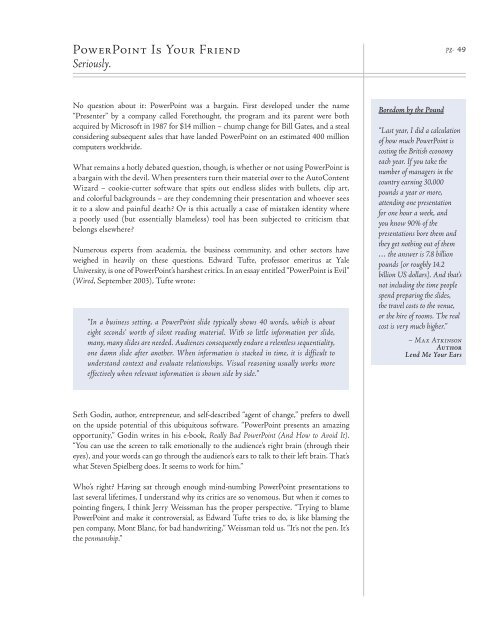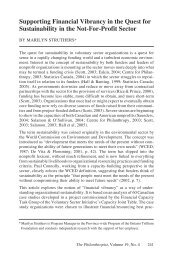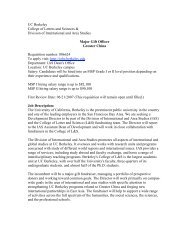Why Bad Presentations Happen to Good Causes - The Goodman ...
Why Bad Presentations Happen to Good Causes - The Goodman ...
Why Bad Presentations Happen to Good Causes - The Goodman ...
Create successful ePaper yourself
Turn your PDF publications into a flip-book with our unique Google optimized e-Paper software.
PowerPoint Is Your Friend<br />
Seriously.<br />
No question about it: PowerPoint was a bargain. First developed under the name<br />
“Presenter” by a company called Forethought, the program and its parent were both<br />
acquired by Microsoft in 1987 for $14 million – chump change for Bill Gates, and a steal<br />
considering subsequent sales that have landed PowerPoint on an estimated 400 million<br />
computers worldwide.<br />
What remains a hotly debated question, though, is whether or not using PowerPoint is<br />
a bargain with the devil. When presenters turn their material over <strong>to</strong> the Au<strong>to</strong>Content<br />
Wizard – cookie-cutter software that spits out endless slides with bullets, clip art,<br />
and colorful backgrounds – are they condemning their presentation and whoever sees<br />
it <strong>to</strong> a slow and painful death? Or is this actually a case of mistaken identity where<br />
a poorly used (but essentially blameless) <strong>to</strong>ol has been subjected <strong>to</strong> criticism that<br />
belongs elsewhere?<br />
Numerous experts from academia, the business community, and other sec<strong>to</strong>rs have<br />
weighed in heavily on these questions. Edward Tufte, professor emeritus at Yale<br />
University, is one of PowerPoint’s harshest critics. In an essay entitled “PowerPoint is Evil”<br />
(Wired, September 2003), Tufte wrote:<br />
“In a business setting, a PowerPoint slide typically shows 40 words, which is about<br />
eight seconds’ worth of silent reading material. With so little information per slide,<br />
many, many slides are needed. Audiences consequently endure a relentless sequentiality,<br />
one damn slide after another. When information is stacked in time, it is difficult <strong>to</strong><br />
understand context and evaluate relationships. Visual reasoning usually works more<br />
effectively when relevant information is shown side by side.”<br />
Seth Godin, author, entrepreneur, and self-described “agent of change,” prefers <strong>to</strong> dwell<br />
on the upside potential of this ubiqui<strong>to</strong>us software. “PowerPoint presents an amazing<br />
opportunity,” Godin writes in his e-book, Really <strong>Bad</strong> PowerPoint (And How <strong>to</strong> Avoid It).<br />
“You can use the screen <strong>to</strong> talk emotionally <strong>to</strong> the audience’s right brain (through their<br />
eyes), and your words can go through the audience’s ears <strong>to</strong> talk <strong>to</strong> their left brain. That’s<br />
what Steven Spielberg does. It seems <strong>to</strong> work for him.”<br />
Who’s right? Having sat through enough mind-numbing PowerPoint presentations <strong>to</strong><br />
last several lifetimes, I understand why its critics are so venomous. But when it comes <strong>to</strong><br />
pointing fingers, I think Jerry Weissman has the proper perspective. “Trying <strong>to</strong> blame<br />
PowerPoint and make it controversial, as Edward Tufte tries <strong>to</strong> do, is like blaming the<br />
pen company, Mont Blanc, for bad handwriting,” Weissman <strong>to</strong>ld us. “It’s not the pen. It’s<br />
the penmanship.”<br />
Boredom by the Pound<br />
pg. 49<br />
“Last year, I did a calculation<br />
of how much PowerPoint is<br />
costing the British economy<br />
each year. If you take the<br />
number of managers in the<br />
country earning 30,000<br />
pounds a year or more,<br />
attending one presentation<br />
for one hour a week, and<br />
you know 90% of the<br />
presentations bore them and<br />
they get nothing out of them<br />
… the answer is 7.8 billion<br />
pounds [or roughly 14.2<br />
billion US dollars]. And that’s<br />
not including the time people<br />
spend preparing the slides,<br />
the travel costs <strong>to</strong> the venue,<br />
or the hire of rooms. <strong>The</strong> real<br />
cost is very much higher.”<br />
– Max Atkinson<br />
Author<br />
Lend Me Your Ears













